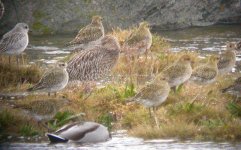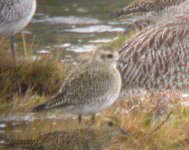CJW
Hit-and-run WUM
All,
I’ve just been watching a strange Golden Plover sp. During my lunch break and was wondering what your thoughts were:
Same size as Eurasian Golden Plover - didn’t appear ‘slim’, but then, like the rest of the flock it was ‘fluffed up’ (it’s very cold out there today!)
Distinctly capped appearance with a very white supercillium, which appeared to extend across the bird’s forehead (although it was slightly more ‘buffy’ at this point)
Generally paler than EGP but still with a golden cast to the mantle and scapulars – sort of part way between Grey Plover and EGP in overall appearance.
The wings appeared long – certainly extending beyond the tail – but, possibly because of the bird’s hunched/fluffed posture, not appearing particularly attenuated.
I’ve got a couple of (poor) photos, which I will post later when I can download them onto my PC (I’m writing this in work).
Is there anything in the above, brief description that can confirm/refute what I am obviously suspecting?
Thanks,
Chris
I’ve just been watching a strange Golden Plover sp. During my lunch break and was wondering what your thoughts were:
Same size as Eurasian Golden Plover - didn’t appear ‘slim’, but then, like the rest of the flock it was ‘fluffed up’ (it’s very cold out there today!)
Distinctly capped appearance with a very white supercillium, which appeared to extend across the bird’s forehead (although it was slightly more ‘buffy’ at this point)
Generally paler than EGP but still with a golden cast to the mantle and scapulars – sort of part way between Grey Plover and EGP in overall appearance.
The wings appeared long – certainly extending beyond the tail – but, possibly because of the bird’s hunched/fluffed posture, not appearing particularly attenuated.
I’ve got a couple of (poor) photos, which I will post later when I can download them onto my PC (I’m writing this in work).
Is there anything in the above, brief description that can confirm/refute what I am obviously suspecting?
Thanks,
Chris





